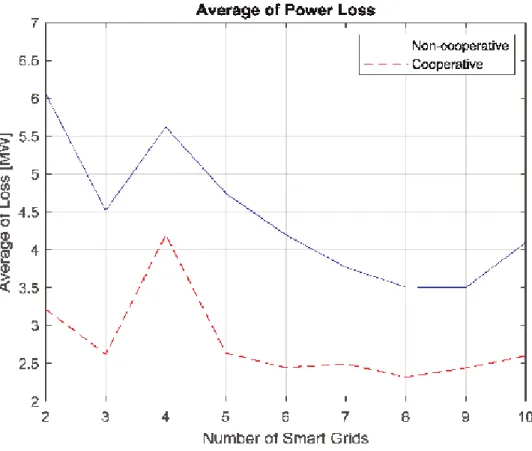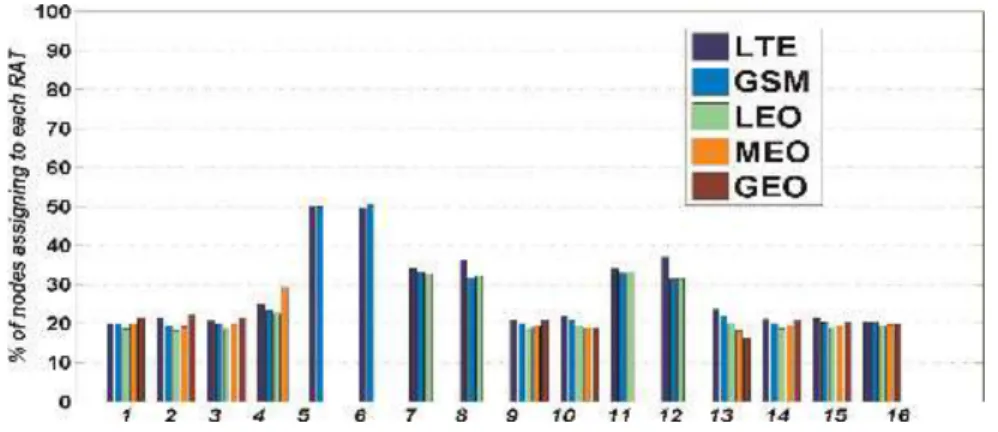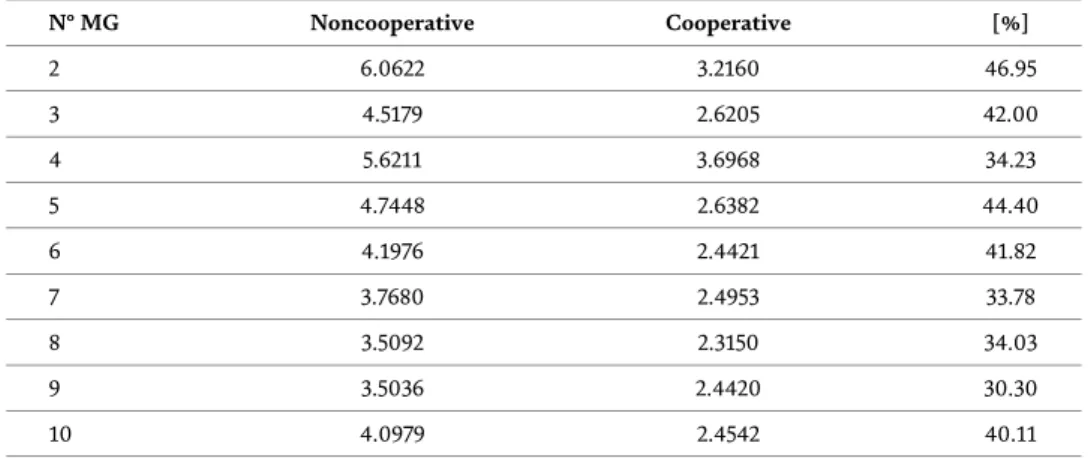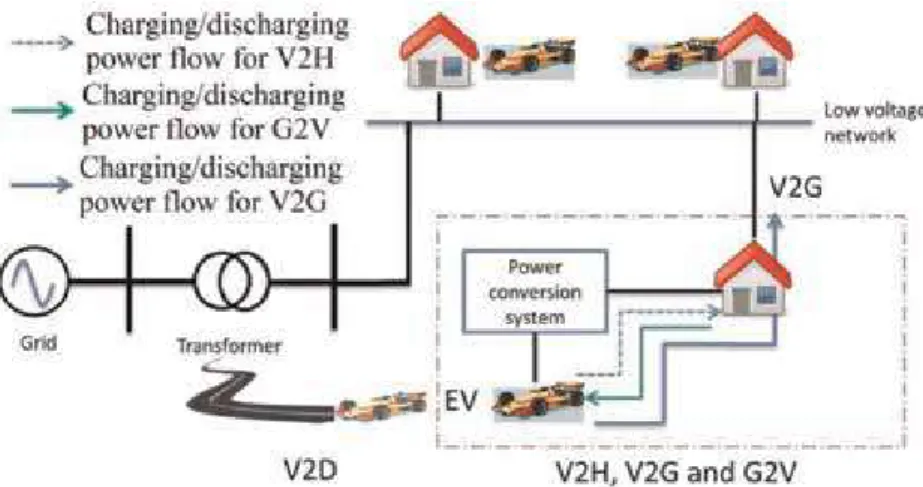Ref—the reference case where noDRrequest is enforced in the network and the demand varies according to Figure 17;. Qwindh,min≤Qwindh ≤Qwindh,max (19) 4. The limits for the tap changer of the transformer must be according to When you substitute these values from Eq. 6), the expression for the power to be delivered by the transformer station to Smart Gridi∈Now reached [1]:.

Introduction
The concept of active distribution network (ADN) has been developed to address the high penetration of renewable resources in the distribution network. Various communication standards to facilitate standards-based communication in the distribution network have been proposed in the literature. The concept of active distribution network (ADN) will allow distribution networks to integrate DERs efficiently by addressing the above challenges by incorporating information and communication technologies into distribution systems [1].
In ADNs, the different components are geographically far apart, so coordinated operation requires a communications infrastructure over a wide area. This chapter provides a comprehensive analysis of these state-of-the-art standards and protocols for use in ADNs. Various communication technologies have been studied in the literature for information exchange between different parts of the ADN [3, 4].
This chapter lists the various communication technologies that can be used in ADNs and provides a detailed study. This chapter discusses the various simulator tools for evaluating the performance of ADN communication networks.
Active distribution networks: the concept
Challenges with traditional distribution system
In this regard, the IEC 61850 standard appears as one of the most popular and widely accepted solutions, as it is based on an interoperability approach and provides flexibility in implementation [2]. The presence of RER and DER in ADN introduces interruptions, so the communication architecture for ADN must be highly scalable. Web protocols have been used to solve the scalability problem in smart grid communication architectures.
The proposed chapter will present a detailed study of the various web protocols and their suitability for ADNs [5]. The performance of various communication network architectures is evaluated for network delay, quality of service (QoS), robustness, reliability, and data security to determine their applicability and suitability in ADNs. An overview of various real-time testbeds and state-of-the-art co-simulation platforms of interface power system simulators and ICT simulators will be presented.
Evolution of active distribution network
Architecture of active distribution network
The high penetration of DG into the distribution system introduces bidirectional power flows in the distribution network and causes voltage rise and increased levels of fault currents. However, with the spread of DG in the distribution network, there are new challenges in the management and control of the network and in ensuring a reliable and high-quality supply of electricity to consumers. In order to make the most efficient use of the existing network infrastructure and manage DG for reliable and safe electricity supply, the ADN management concept was developed.
ADN will enable efficient integration of DGs with the existing distribution infrastructure by taking maximum advantage of the inherent features of DGs. This requires the planning and operation of the distribution network by considering the two-way power flow in the network. However, most of the DGs are non-dispatchable in nature and therefore matching of power production profile with that of the load demand profile cannot be guaranteed at all times.
The power requirements of the electric grid are shared with the DP owner through the aggregator. Also, since small-scale DPs do not fall under the direct supervision and control of DSOs and thus DSOs receive services from aggregators for monitoring and controlling DPs.
Communication configurations for ADNs: standards and technologies The cornerstone for the ADN management is the ability of multiple entities such
Communication standards for ADN .1 IEEE 1547
- IEEE P2030
- IEC 60870-5
- IEEE C37.118.1/2
- IEC 61850
These new measurements can then be used in disturbance management, predictive maintenance, and to increase power system stability and load. The IEEE 1547 standard [6] defines the rules for the interconnection of different distributed resources (DR) in electric power systems (EPS). IEEE 1547.1: IEEE Standard Compliance Test Procedures for Equipment Interconnecting Distributed Resources to Power Systems.
IEEE 1547.2: IEEE Application Guide for IEEE 1547, IEEE Standard for Interconnecting Distributed Resources with Electric Power Systems. IEEE 1547.3: IEEE Guide for Monitoring, Information Exchange, and Control of Distributed Resources Associated with Electric Power Systems. The purpose of the standard is to specify requirements and create a framework to achieve interoperability between the IEDs supplied by different suppliers.
The gradual increase in burst retransmission time is adopted to increase network reliability, as the GOOSE message conveys critical commands. The IEC 61850 standard specifies a set of services and abstract objects that allow applications to work in an independent manner from the underlying protocol.
IEC 61850-based communication configuration for ADN
For the design of IEC 61850-based communication architecture for ADN, the entities or components of the ADN are modeled according to the IEC 61850 standard. MU is the main equipment at the process level, which receives current and voltage samples from non-conventional instrument transformers and then converts them to digital data packets and communicates to other IEDs, as per communication mechanisms described in IEC 61850-9-2LE [17]. A synchronization accuracy of 1 μs is required by the "IEC 61850-9-2LE" process bus implementation guidelines to synchronize the MUs in SAS.
This modeling requires the realization of ADN components in terms of logical nodes and data objects. The standard proposes to model the various power system components using appropriate logic nodes according to IEC 61850. However, several ADN entities such as phasor measurement unit (PMU), controlled loads, distribution static compensator (DSTATCOM), electric vehicle (EV), solar house system (SHS) are not modeled in the IEC 61850 standard.
Aware of this knowledge gap, authors in [18] proposed the DSTATCOM controller information model according to the IEC 61850 standard. The IEC 61850 based model of SHS and smart meters to manage the tariff structure for bi-directional energy transmission is presented in [24].
Performance evaluation of ADN
Performance evaluation metrics
To ensure this foolproof communication, there are certain communication parameters that every ADN communication network must adhere to. Network latency is the time elapsed in transferring a data packet from source to destination in a communication network. Data delivery criticality is defined according to the type of data being communicated in an ADN communication network.
Providing effective QoS in ADN communication network is becoming a major aspect in today's enterprise communication network. The most important requirement for an ADN communication network is the implementation of technologies with end-to-end integration with compatibility between them. In an ADN communication network scenario, a large number of DERs and other devices are connected to an ADN network.
Reliability is defined as an attribute of a communication network that operates consistently according to specifications. Durability is defined as the attribute of a communication network in which it is not vulnerable to any type of failure and its performance is guaranteed.
Performance evaluation tools
An ADN communications network will be a wide area network and will sometimes use the resources of a public shared network such as the Internet. A use case could be a scenario where a fault occurs in a part of ADN and respective protection devices issue a trip signal to the breaker. This trip command in the form of GOOSE message in an IEC 61850 based ADN must be communicated within a set delay.
Availability of a communication network is defined as a property that a communication network device should be readily available at all times and that there should be no denial of service (DoS). To ensure functions such as protection, operation, management and control of ADN, a highly reliable, deterministic, robust and available communication network must be developed. Also, a large number of standardization organizations of the ICT and energy industry consider ADN standardization a priority issue.
Due to the presence of devices from several manufacturers in the ADN communication network, standardization activities are necessary to ensure smooth deployments. Existing smart grid standards originate from several standards organizations and must be continuously developed to cope with changes in regulatory, technical, political and organizational aspects.
Cybersecurity in IEC 61850-based ADN
These tools help in presenting the communication network performance in terms of latency, throughput, jitter etc. OPNET/Riverbed Modeler: It provides a comprehensive simulation environment for modeling the communication network and distribution network. Qualnet: It is a commercial (licensed) network simulator from Scalable Network Technologies (SNT), originally developed for defense projects.
It is used to predict performance of wireless and wired networks and is an ultra-high fidelity software. The IEC 61850-based communication for ADN relies on data transmission in terms of IEC 61850-based messages over a wide area network to realize various features of smart communication. Ensuring cybersecurity in smart grids using IEC 61850 requires implementation of IEC 62351's guidelines for different power system operations.
Furthermore, to fully implement XMPP in IEC 61850-based networks, it must be embedded in other IEC 61850 messages, namely R-GOOSE and R-SV. It was concluded that the existing security scheme does not meet the time criticality of GOOSE messages and an amendment of IEC 62351-6 is needed to provide effective cybersecurity and timing requirements for IEC 61850 based messages.
Conclusion
The scope definition additionally defines, for example, the functional unit, data specifications, assumptions and limitations of the assessment [15, 19]. The next few lines show the total exergy composition of a system. The variables vandh correspond to the speed and height relative to that of the exergy reference environment (v0= 0,h0= 0) [18].
In addition, the required framework for estimating the operational electricity consumption of ICT equipment will be provided. AN (more precisely RAN) components include base transmitter station (BTS) and base station controller (BSC) stacks for GSM RAN and Node B stacks and radio network controller (RNC) stacks for UMTS RAN. We first present an inventory of the ICT equipment required for E-LCA of the overall system.
Lifetime assumptions of the ICT equipment deployed in the RAN, CN, as well as the DCC are provided in Table 5. Based on that, meaningful and useful conclusions about the environmental sustainability of the ICT equipment are provided. In the case of the advanced metering infrastructure (AMI) and home area network (HAN) scenarios (i.e. Scenarios 2.a–2.c), the utility equipment (UE) was determined to be the ICT equipment category group with the highest share in the cumulative embodied exergy consumption (EEG).
However, the assessment of the cumulative operational exergy consumption (OEC) revealed a high dependence on the utilization intensity of HANs. The user units (UUs) were determined to be the second largest contributor to total cumulative EEC in the overall system. Assessing the impact of intelligent DSM methods in the Galapagos Islands towards a smart grid.


![Figure 4 shows the results of a LCA of three different smartphones, namely, an Apple iPhone 4S, a Nokia Lumia 920, and a Huawei U8652 [29]](https://thumb-ap.123doks.com/thumbv2/1libvncom/9200949.0/135.765.142.621.772.993/figure-results-different-smartphones-apple-iphone-nokia-huawei.webp)

